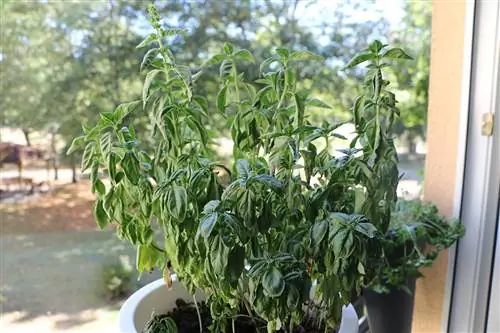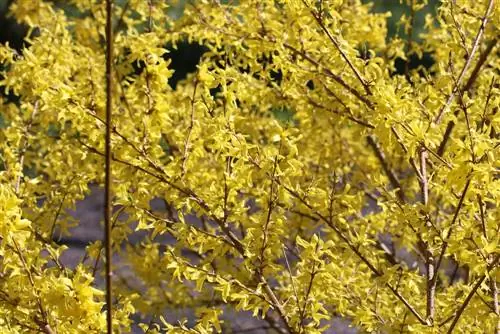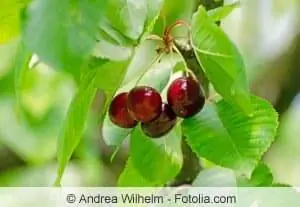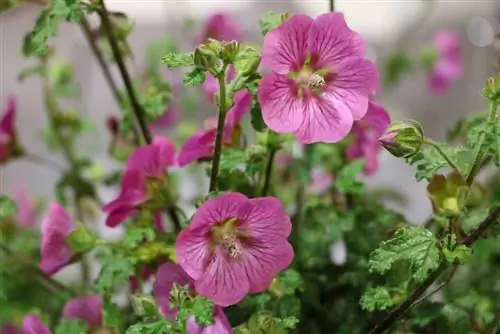- Author admin [email protected].
- Public 2023-12-17 03:39.
- Last modified 2025-06-01 06:48.
Tree basil is also becoming increasingly popular in home cooking. It makes sense to cultivate this tasty herb yourself. However, since the plant is originally native to Asia and Africa, it needs warmth and sun. If you want to preserve the popular, actually perennial herb over the winter, you need suitable winter quarters in the local latitudes. The shrub basil thanks such a change of location from summer to winter with a long life and an impressive size of up to one meter.
Location in summer
Cultivation in a bucket is also recommended for the summer, but the bush basil can just as easily find a place in the garden bed. The location must always be warm, bright, sunny to partially shaded and ideally protected from the wind so that the plant feels really comfortable. Therefore, a south-facing balcony or a sun-drenched terrace is also the right location for the plants cultivated in the pot. In this way, the herbal plant exudes its pleasant scent directly at the seat and also keeps away flies and other insects that are deterred by this intense smell.
Tip:
If bush basil is cultivated in a bucket, it is easier to move it to a frost-protected place in winter. Basil cultivated in the bed must be dug up early in the fall and placed in a pot to overwinter.
Location in winter - overwintering
Since shrub basil cannot tolerate any frost, it must be brought indoors early on. The rule here is that it's better too early than too late, because the herb plant also feels at home indoors. If you don't have a garden, terrace or balcony, you can also grow your basil plants in a south-facing window with sufficient warmth and brightness in summer. On very warm days, you can also place the pot in an open window, although drafts must be absolutely avoided. In winter, the location and environment for the perennial shrub basil should look like this:
- bright, airy, not too warm place
- Avoid drafts
- a bright staircase or a place in the poorly heated bedroom by a window is ideal
- do not place it above a heater, the warm air from below is not tolerated well
- The herb plant also prefers a place in the unheated winter garden
- A temperature of 15° - 20° Celsius for wintering is ideal
- The plant cannot tolerate temperatures below 10° Celsius
- Therefore, it must be brought inside and protected before the outside temperatures drop below 10° Celsius, which can occur in autumn, especially at night
- The pot in which the plant overwinters needs to be of sufficient size
- This is especially important to consider when bedding plants are moved into a pot for the winter after summer
- a size of 15-20 cm in diameter is ideal
- Drainage must also be present here
- Plastic containers are ideal for winter storage as terracotta pots remove moisture from the soil
- Even in winter, bush basil needs to be watered regularly but moderately
- also avoid waterlogging and drying out
- The herb plant is also fertilized regularly in winter
- every 20 to 30 days with a special herbal fertilizer is ideal
Substrate & Soil
A nutrient-rich soil, which should above all be permeable, is ideal for shrub basil. When preparing the bucket, you should therefore not forego installing a drainage system. Likewise, for plants cultivated in garden beds, care must be taken to ensure that the soil is permeable, as the herb plant does not tolerate waterlogging. If it is too solid, mixing in sand can help. Otherwise, it is sufficient for good growth if compost is added to the garden soil. Extra herb soil from selected garden stores is also suitable for potted plants.
Tip:
Pots with a built-in irrigation system, such as those used for a longer holiday absence, are ideal for bush basil, because there is no waterlogging and the plants are watered from below and not over the ground.
Watering & Fertilizing
Shrub basil needs regular water, although waterlogging and a longer dry period must be avoided. Especially in very sunny locations, the basil should be watered regularly in the evening or early morning. When fertilizing, you should proceed as follows:
- fertilize about every five weeks
- You can use commercially available liquid fertilizer
- a well-stocked specialist shop also offers extra fertilizer for herb plants
- otherwise long-term fertilizer such as blue grain can also be used
- The five-week cycle will then be omitted
Tip:
The hobby gardener can tell from hanging, limp leaves that his basil bush is lacking water. If the bush is then watered immediately, the leaves will stand up again. But in such a case, action must be taken immediately and, in addition to adding water, the bucket must also be briefly removed from the blazing sun.
Sowing
Basil is ideally cultivated with either self-harvested or purchased seeds. The plants, which are often sold in pots in the supermarket, are only suitable for direct use in the kitchen and not for planting in the home garden. When sowing, you should therefore proceed as follows:
- Prepare growing pots with growing soil
- since the seeds need a temperature of over 20° Celsius to germinate, choose a warm location on a windowsill
- so you can start sowing in February or March
- Stick the seeds lightly into the soil and do not cover them
- keep slightly moist
- Once the seedlings, which usually appear after a few days, have grown into small plants, they can be transplanted to their location
- this should only happen after the Ice Saints in May, when no more frost is expected
Tip:
Shrub basil flowers, but this damages the growth, so the flowers are usually cut. However, if you want to grow new plants from sowing next year, leave some flowers on your plant and allow seeds to ripen. These are then cut and hung to dry in a warm, dry place, such as a boiler room.
Cutting
One advantage of bush basil is its rare flowers. Only the tender and young shoots are very tasty, but these are no longer formed once flowers have appeared on the plant. If you always want to harvest basil for the kitchen, you have to cut the flowers when they have formed. A larger cut is advisable in autumn, so that the plant can develop new shoots and leaves again during the winter and excessive woodiness is curbed. The cut parts can be dried and thus preserved for use in the kitchen over the winter.
Repotting
Repotting is always necessary when the roots of the fast-growing plant are already emerging from the pot. The plants cultivated in the bed in summer must also be moved to a suitable pot for winter quarters. When it comes to bush basil, it must always be remembered that the herb plant can reach a height of up to one meter, so the pot must also be chosen large enough. When removing it from a garden bed, it must be taken into account that the roots have already become very large. It is better to dig it out of the ground far enough around the plant with a spade so that the roots are not damaged.
Conclusion
Overwintering a bush basil requires experienced hands, because it is not quite as easy as it might be with other plants. But if you follow a few tips on winter care, you can enjoy your basil bush for several years. Care in summer is usually less complicated than in winter. Even over the winter months, the herb plant does not hibernate but continues to need liquid and fertilizer. The winter quarters must also be chosen very carefully because it must not be too warm, bright and without drafts. Hobby gardeners who have an unheated winter garden have an advantage, but the shrub basil can survive the winter well even on a bright windowsill without heating.






